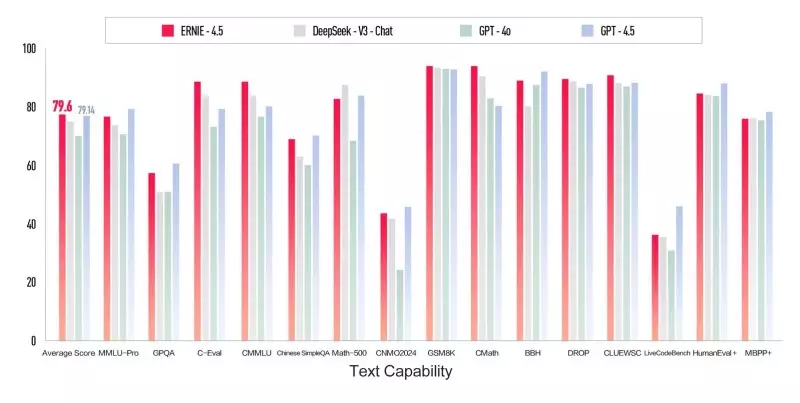This past weekend, Baidu, a leader in Chinese internet technology, unveiled two revolutionary AI models: ERNIE 4.5 and ERNIE X1. These state-of-the-art systems mark a monumental step forward in artificial intelligence. ERNIE 4.5 is a multimodal language model, while ERNIE X1 specializes in reasoning tasks. With claims of superior performance compared to competitors like OpenAI’s GPT-4.5 and DeepSeek’s models, Baidu is not just making headlines; it’s setting a new standard in the competitive landscape of AI technology.
The timing of Baidu’s announcement is particularly noteworthy as it coincides with a surge of interest in AI, particularly those grounded in technological enhancements that can better serve various industries. This launch is emblematic of a critical shift in the AI narrative—a shift towards increased performance at a fraction of the cost.
The Performance Metrics and Benchmarking
Baidu asserts that ERNIE 4.5 and ERNIE X1 excel across key performance indicators, including crucial benchmarks such as C-Eval and CMMLU, designed specifically for evaluating Chinese language models. In a world rapidly adopting AI solutions for diverse applications, the specifications of these models are not merely technicalities but are central to their practical effectiveness.
However, the metrics surrounding these models also reveal sobering realities. While the promise of up to 99% lower costs in comparison to OpenAI’s offerings appears attractive, one must critically consider the underlying limitations. For instance, the context window of ERNIE 4.5, pegged at a mere 8,000 tokens, is significantly smaller than that of its rivals. This raises essential questions: What applications truly benefit from such a limited scope? Is Baidu merely capitalizing on its regional strengths while compromising broader applicability? André Lemaire, an AI researcher on X, aptly pointed out that such constraints might render ERNIE 4.5 more suitable for tasks like customer service chatbots rather than complex, multifaceted human interactions.
Multimodal Capabilities and Advancements
Baidu’s latest model, ERNIE 4.5, introduces several unique enhancements, distinguishing it from existing models. The architecture leverages cutting-edge technologies such as FlashMask Dynamic Attention Masking and heterogeneous multimodal mixture-of-experts. These innovations could potentially revolutionize how AI comprehends and generates content.
Yet, the question lingers: does superior architecture guarantee superior output? While Baidu’s advancements in logical reasoning and memory retention are commendable, they must be tested in real-world implementations. Enhanced hallucination prevention and logical reasoning may be noteworthy on paper, but the key lies in their performance during practical applications. For organizations contemplating these models, it is imperative to critically evaluate their responses to complex queries or ambiguous texts.
The Distinctive Design of ERNIE X1
Moving into the realm of reasoning, ERNIE X1 stands out as an innovative model emphasizing advanced cognitive skills such as planning and reflection. Its design offers organizations tools for elevated tasks ranging from document-based Q&A to AI-generated image interpretations. This demonstrates Baidu’s commitment to not only enhancing language comprehension but creating a deeply cognitive AI capable of tackling intricate reasoning challenges.
However, the underlying principles guiding the development—Progressive Reinforcement Learning and an End-to-End Training model—serve as a double-edged sword. While innovative, they evoke skepticism regarding their effectiveness across different contexts. Will ERNIE X1 face challenges similar to those encountered by early AI models? Can it adapt its reasoning capabilities when thrown into varied real-world situations?
Implications for Businesses and Organizations
The commercial implications of these launches are substantial. For executives—CIOs, CTOs, and DevOps leaders—ERNIE 4.5 and ERNIE X1 offer compounding possibilities. The prospect of leveraging advanced multimodal and reasoning capabilities for cost efficiencies must be weighed against various considerations: performance consistency, integration flexibility, and data security are paramount.
Baidu’s strategy to embed these models within their broader ecosystem, including Baidu Search, has the potential to streamline operational processes across sectors like customer service and content generation. Yet businesses must navigate the present constraints in licensing options and data privacy regulations—factors that could complicate smooth integration.
Furthermore, enterprises eager to capitalize on these technologies should remain vigilant and proactive, waiting until June 2025 for the promised open-source release of ERNIE 4.5. Evaluation based on practical applications in specific environments will be crucial before making substantial commitments. The blend of potential and limitation within these models illustrates the complex landscape of AI innovations.
Setting the Stage for Future Developments
In sum, Baidu’s introduction of ERNIE 4.5 and ERNIE X1 signifies a pivotal moment in the realms of multimodal and reasoning-focused AI technologies. With ambitious plans for continued improvements, Baidu aims to secure its position amidst fast-paced AI advancements. Integrating performance with cost-efficiency represents a calculated move that could attract businesses and individual users to its ecosystem. Exciting times lie ahead for AI, and Baidu’s latest models exemplify this transformative era’s potential, shaping the way we interact with technology in the future.


Leave a Reply